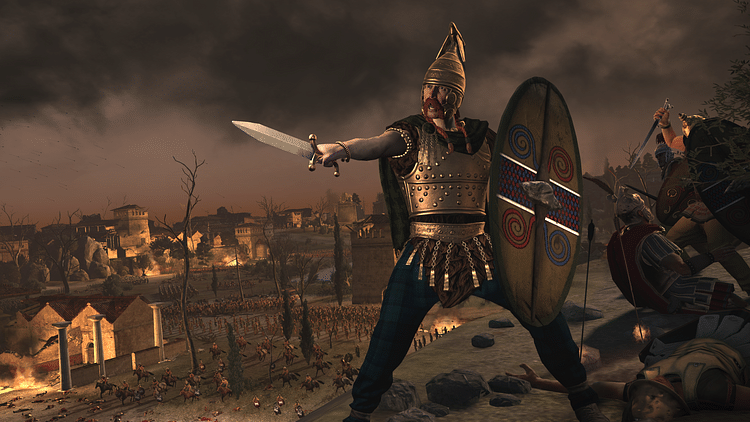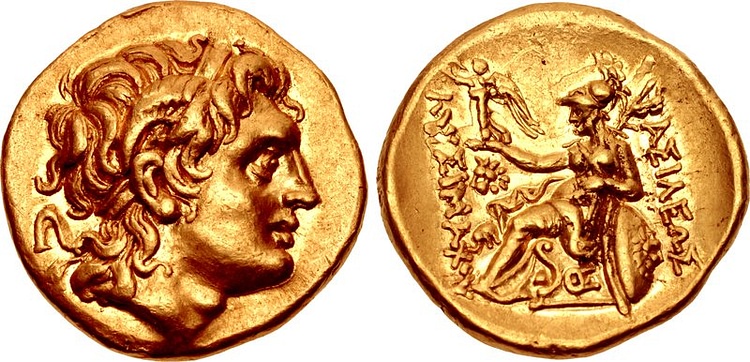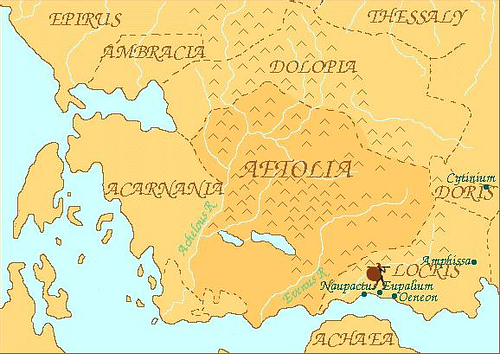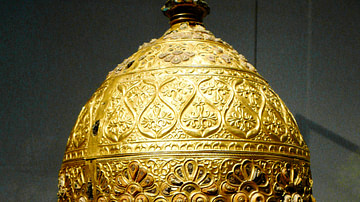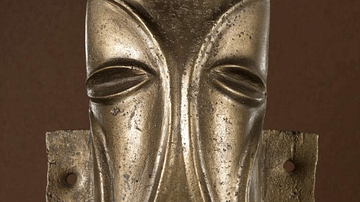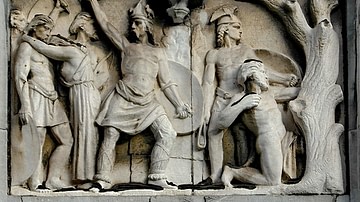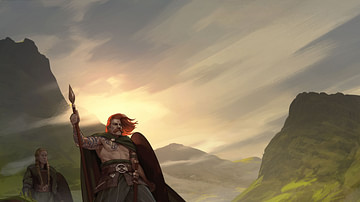Between the 5th and 4th centuries BCE, Celtic tribes moved en masse into southern Europe, intent on seizing land and wealth to feed their swelling numbers. As these tribes began crossing the Alps, they came into conflict with the Romans and Greeks living around the Mediterranean. The death of Alexander the Great (356 BCE - 323 BCE) made Greece appear like an easy target to many opportunistic Celtic chieftains who led their people into the Balkans, first to Thrace and Illyria before pressing forward towards Macedon.

While in the Balkans, these tribes managed to conquer several Greek, Illyrian, and Thracian armies, carving out territories in short order. Under the leadership of a king named Brennus, a coalition of Celtic tribes attempted to invade Greece itself. The forces of Brennus were eventually defeated and scattered by the Greeks at Delphi in 279 BCE. After this, the Celtic tribes who had entered the Balkans suffered other defeats, and many of them fled into Asia Minor. The Celtic expeditions into Greece ultimately ended in ruin for the Celts, but they had a lasting impact on the politics of the Mediterranean and resulted in the creation of the Celtic kingdom of Galatia in the highlands of Anatolia.
Early Interactions Between Celts & Greeks
Early Greek accounts of the Celts were somewhat neutral and curious, and little attention was given to the strange peoples living on the northern extremity of the Greek world. The Greeks were eager colonizers, and Greek communities had sprung up in Asia Minor, North Africa, and Western Europe by the 7th century BCE.
Massalia (which eventually became the city of Marseilles) was just such a colony, founded around 600 BCE. Nestled on the northwestern coast of the Mediterranean, it was one of the earliest points of contact between the Celts and the Greeks. The earliest surviving mention of the Celts is from Hecataeus of Miletus, who described a Celtic village north of Massalia. Archaeological evidence has revealed that there was extensive trading between the Greeks of Massalia and nearby Celtic settlements.
Celtic elites traded for wine, drinking vessels, and other status symbols with merchants from Greece and Etruscan Italy. These exotic luxuries allowed Celtic leaders to broadcast their status and generosity with extravagant feasts and gift-giving. In this way, the network of trade between the Mediterranean and Central Europe helped to support the social hierarchy.
Scarcity & Migration in Ancient Europe
Ancient authors are unanimous in describing the unrest which afflicted Western and Central Europe in the late 4th and early 3rd century BCE. Overpopulation and a scarcity of resources are given as the reason for this deprivation, and archaeological evidence indicates that the population of Europe had begun to boom at this time. The lack of resources may have motivated some war leaders to begin raiding further and further out where there was more food and wealth.
Barry Cunliffe suggested that the first waves of Celtic migration began this way, as increasingly intense, long-distance raiding in the 6th century BCE. Eventually, these long-distance raids became attempts at settlement as these migrating tribes established new villages. These groups were not solely warriors; there were equal numbers of women, children, and elderly with them. These individuals represented an earnest effort at settlement, rather than a simple invasion force.
Yea and one day hereafter thee shall come upon us a common struggle, when the Titans of a later day shall rouse up against the [Greeks] barbarian sword and Celtic war, and from the furthest West rush on like snowflakes and in number as the stars when they flock most thickly in the sky; forts too (and the villages of the Locrians and Delphian heights) and Crisaean plains and (glens of the mainland) be thronged about and around, and shall behold the rich smoke of their burning neighbour, and no longer by hearsay only; but already beside the temple behold the ranks of the foemen, and already beside my tripods the swords and cruel belts and hateful shields, which shall cause an evil journey to the foolish tribe of the Galatians. (Callim., Hymns, 4.171-185)
The majority of these migrant tribes moved to the south and the east where they found more favourable climate and greater wealth. Greco-Roman authors describe the Celts desiring to travel south on account of the luxurious items to be found around the Mediterranean. The goods mentioned by these authors (grapes, figs, wine, olives) were all highly sought after in Europe and imported heavily by Celtic settlements.
Greek and Roman accounts of these conflicts are some of the earliest surviving written records of the Celts, as the Celts themselves did not leave textual histories. The violent nature of these early interactions helped shape the Classical perception of the Celts as a warlike, barbaric people.
Early Celtic Migrations Into Southern Europe
The Roman historian Livy (59 BCE - 17 CE) claims that Celtic tribes from Gaul had begun settling south of the Alps by 600 BCE. It is likely that the earliest excursions into Italy were made by smaller groups, and this rapidly spiralled into a massive exodus of Gallic tribes south in the 5th and 4th centuries BCE.
Groups of Celts settled in Cisalpine Gaul around 400 BCE and, from there, raided the cities of Italy, terrorizing their new neighbours. The situation in Italy reached its climax in 390 BCE when a Celtic chief known as Brennus defeated the Roman army at the Allia River, and then went on to sack Rome. This dramatic incident burned a hole into the collective memory of the Roman people and led to an escalation of the conflict between Celts and Romans. After this incident, Gauls continued to send raids into Italy, even reaching as far south as Apulia, in the heel of Italy's boot. However, Rome defeated the tribes living on the Adriatic Coast in a series of battles between 285-282 BCE and firmly established itself as a dominant power in the region.
Around the 4th century BCE, Celtic groups moved east into the Middle Danube and had formed settlements in modern-day Romania and Hungary. The mounting aggression of the Roman Republic placed new pressure on the Celtic tribes living around the Adriatic and may have been a motivating factor in a new wave of migration that pushed into the Balkans. Celtic tribes began invading Illyria, but the region under Macedonian hegemony while Philip II (383 - 336 BCE) and Alexander the Great (356 BCE - 323 BCE) ruled - Thrace, Greece, and Macedonia - was largely avoided.
Many Celtic warriors who moved into the Mediterranean found a new niche as mercenaries. By 385 BCE, the Greek tyrant Dionysius I of Syracuse had begun recruiting Celtic and Iberian mercenaries to use in Greece and Italy. Some of these were sent by Dionysius I to assist the Spartans (Lacedaemonians) in their wars against the Thebans, where they won distinction.
From Sicily, Celts and Iberians to the number of two thousand sailed to Corinth, for they had been sent by the tyrant Dionysius to fight in alliance with the Lacedaemonians, and had received pay for five months. The Greeks, in order to make trial of them, led them forth; and they proved their worth in hand-to-hand fighting and in battles and many both of the Boeotians and of their allies were slain by them. Accordingly, having won repute for superior dexterity and courage and rendered many kinds of service, they were given awards by the Lacedaemonians and sent back home at the close of the summer to Sicily. (Diod. Sic., 15.70)
Celtic Expansion in the Wake of Alexander the Great
The sudden death of Alexander the Great in 323 BCE left his massive empire without a clear leader, and a series of wars between Alexander's successors ensued. Realizing that the Greeks were particularly vulnerable, several Celtic chieftains took the opportunity to launch an invasion of the Balkans and the Mediterranean.
Success encouraging them, they betook themselves, in separate bands, some to Greece, and some to Macedonia, laying waste all before them with the sword. Such indeed was the terror of the Gallic name, that even kings, before they were attacked, purchased peace from them with large sums of money. (Justin, 24.4.6-7)
Celtic tribes moved into Thrace and Illyria, defeating the local tribes, before advancing even further south. In 280 BCE, a large coalition of around 85,000 Celts headed for Macedon and Greece. This figure included women and children, as these were also tribal groups rather than organized armies.
A Celtic leader named Bolgios was sent with the remaining army to Macedon. In 279 BCE, Bolgios plundered the countryside of Macedon and went up against the army of Ptolemy Keraunos (r. 281-279 BCE), who had only just seized the Macedonian throne. Ptolemy Keraunos was killed in battle, and the Celts placed his head on a spear as a bloody trophy. This began roughly two years of anarchy as the Balkans were without strong central leadership, and the Celts were on the warpath.
The Other Battle of Thermopylae
The conquests of Philip II and Alexander the Great, and the subsequent Wars of the Diadochi left Greece so weakened that there seemed to be nothing to stop the Celts when they entered Greece in 279 BCE, led by their king Brennus (apparently known by the same name as the man who sacked Rome in 390 BCE). The Greek city-states and kingdoms were all depleted from years of warfare, and many were unwilling to take up arms to defend the rest of Greece.
It was late before the name “Gauls” came into vogue; for anciently they were called Celts both amongst themselves and by others. An army of them mustered and turned towards the Ionian Sea, dispossessed the Illyrian people, all who dwelt as far as Macedonia with the Macedonians themselves, and overran Thessaly. And when they drew near to Thermopylae, the Greeks in general made no move to prevent the inroad of the barbarians, since previously they had been severely defeated by Alexander and Philip. Further, Antipater and Cassander afterwards crushed the Greeks, so that through weakness each state thought no shame of itself taking no part in the defence of the country. (Paus. 1.4.1)
Pausanias (c. 110 - c. 180 CE) in his Description of Greece recounts that the Athenians stepped up to lead an alliance of Greeks against the Celts as they entered Greece. The Greeks decided to meet them in the narrow pass at Thermopylae, where an alliance of Greeks had fought the Persians in 480 BCE. There, the Celts' numerical superiority would be of little to no advantage.
The Celtic king Brennus, realizing that he could not defeat the Greek armies present, sent 40,000 warriors into Aetolia to pillage the cities there. The Aetolian city of Callium was destroyed, and its citizens were brutalized and butchered. Once the Aetolians had heard of this, they abandoned their comrades to defend their homes. The Celts were driven out; only half of them survived to return to Brennus.
The distraction of the Aetolians meant that the Greek forces were significantly weakened, and Brennus was able to find an alternate path around Thermopylae and into Greece. Having bypassed the Greek armies at Thermopylae, Brennus led his forces towards Delphi, the sacred city of Apollo.
Greek accounts claim that Brennus was drawn to Delphi by news of the extravagant treasures held in the temples there, which is likely enough. This time the Greeks had a stroke of good luck, earthquakes and thunderstorms made it difficult for the Celts to lay siege. The Delphians were soon joined by their allies in Greece and together managed to rout the Celts at Delphi. Brennus was gravely injured in the ensuing struggle and later committed suicide over the shame of his defeat.
The Expulsion of the Celts from Greece
After the catastrophic defeat of Brennus, the now leaderless Celts were in no condition to fight. The wounded or slow were left to die by their fleeing comrades, who were pursued and picked off by the Greeks and unable to pillage supplies from the countryside.
The remaining Celtic tribes who had entered Greece were forced to flee further east, into Asia Minor. The flight of the Celts in Anatolia resulted in their settlement in what was named Galatia, derived from Galatae, a Greek term for Celts. Galatia was undoubtedly the most long-lasting and noteworthy community to be formed in this Celtic diaspora, and the Galatians developed a thriving culture of their own, co-existing with their Greek and Near Eastern neighbours.
At the Battle of Lysimachia in 277 BCE, Antigonus II Gonatas (c. 319-239 BCE) ambushed and massacred 18,000 Celts who had been marching towards Greece from Thrace. This decisive victory secured his right to rule Macedon and established his reputation as a capable ruler. Surprisingly, Antigonus II himself was the first of the Hellenistic monarchs to rely on Celtic mercenaries; they were an important part of his army when Pyrrhus of Epirus (c. 319 - 272 BCE) invaded Macedon in 274 BCE.
These events were altogether a disaster for the Celtic tribes which had invaded the Balkans, and the Celts failed to establish any significant communities in Greece or Macedon. Although the coalition of Celtic tribes was utterly shattered after these defeats, Celts continue to appear as mercenaries in the armies of the Hellenistic kingdoms which formed out of the ruins of Alexander's empire. Some of these mercenaries came from the remnants of tribes which had invaded the Mediterranean, but others continued to come from further north, in Central and Western Europe.
The performance of Celtic armies in their battles with the Greeks had earned them a kind of grudging respect. The image of the stoic, honourable, and simplistic Celtic hero, a “noble savage” archetype, became a popular motif in Hellenistic art. In many ways, the Celts filled the role left behind by the Persians and were portrayed as the new enemy of Greek civilization.
- Previously published as The Celtic Invasions of Southern Europe: Part 3 of Celtic History Explained on Magna Celtae


